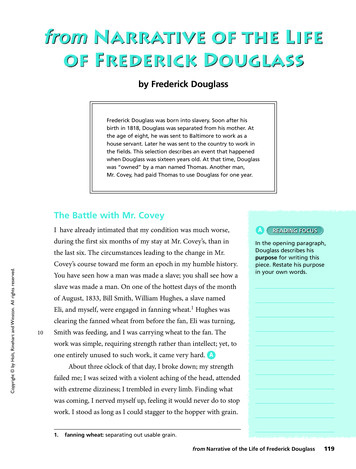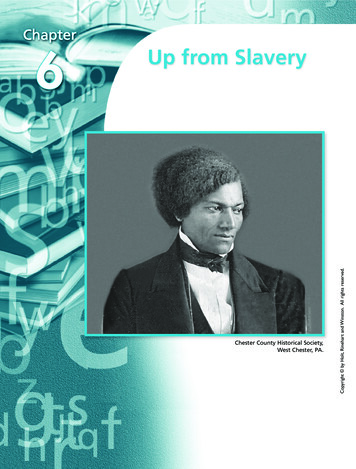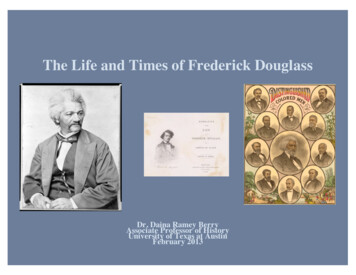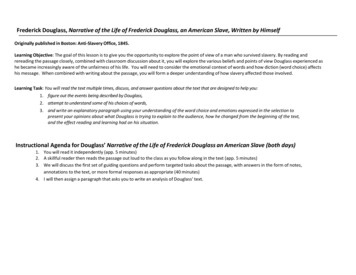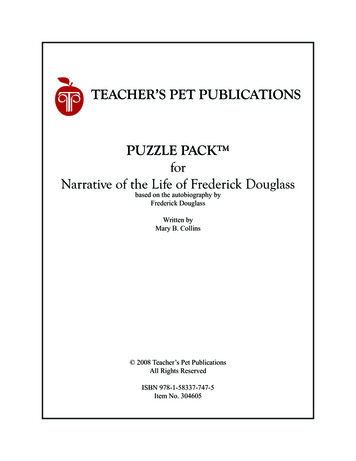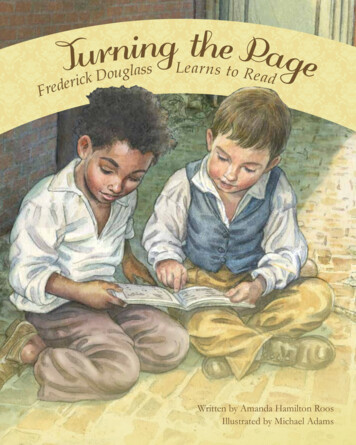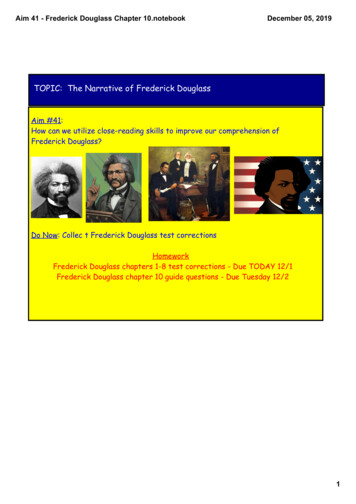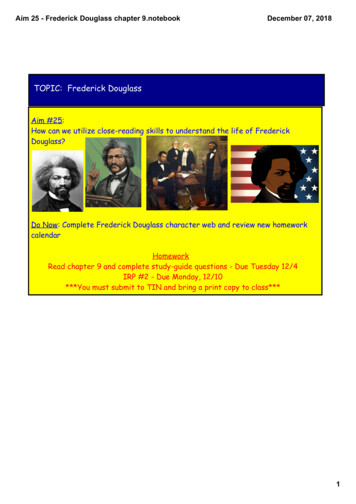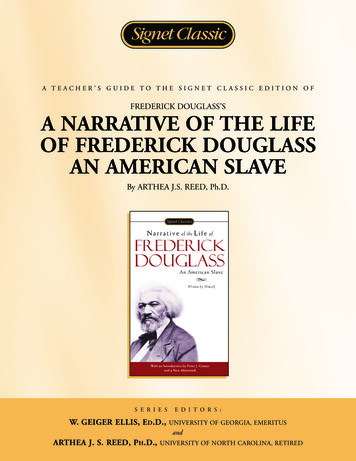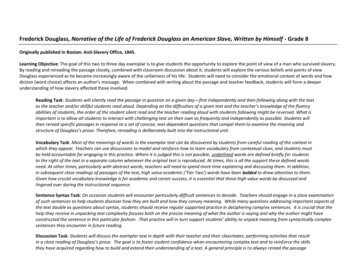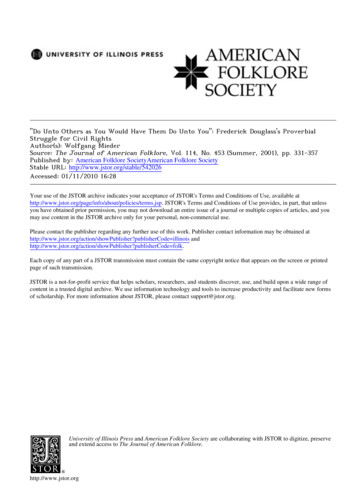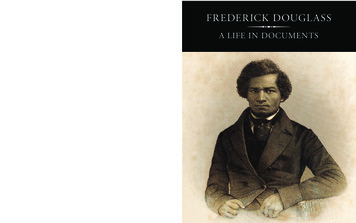
Transcription
FR EDER ICK DOUGL A SSgilderlehrman.org FR EDER ICK DOUGL ASSA LIFE IN DOCUMENTSTHE GILDER LEHR M A N INSTITUTE
FR EDER ICK DOUGL ASSA LIFE IN DOCUMENTS
Frederick Douglass, by an unidentified photographer, ca. 1870(The Gilder Lehrman Institute of American History, GLC06198)
FR EDER ICK DOUGL ASSA LIFE IN DOCUMENTSHistorians Present Documents fromthe Gilder Lehrman CollectionGeneral EditorJAMES G. BASKEREditorsJUSTINE AHLSTROMNICOLE SEARYContributorsEDWARD L. AYERS STEVEN MINTZDAVID W. BLIGHT LUCAS MORELLEIGH K. FOUGHT JAMES OAKESJAMES O. HORTON QUANDRA PRETTYMANLOIS E. HORTON DAVID S. REYNOLDSRANDALL KENNEDY MANISHA SINHANOELLE N. TRENTNew York2018
copyright 201849 w. 45th st., 2nd floornew york , 21-96-3Front Cover: Frontispiece from My Bondage and My Freedom by FrederickDouglass, 1855 (The Gilder Lehrman Institute of American History, GLC05820)
Dedication to Jim HortonJames O. Horton at the opening of Free at Last: A History of the Abolition of Slavery in America atFederal Hall in New York City in November 1997. Horton co-curated this Gilder Lehrman travelingexhibition, which was hosted by more than 130 schools, libraries, and museums in thirty-four states.This volume is dedicated to the memory ofJames Oliver Horton(1943–2017)—scholar, teacher, friend, and supporter ofThe Gilder Lehrman Institute of American HistoryJim Horton, the Benjamin Banneker Professor Emeritus of American Studies and Historyat The George Washington University, was a member of the Gilder Lehrman Institute’sScholarly Advisory Board from the Institute’s founding in 1994; led Teacher Seminarsfrom 1997 to 2003; wrote essays for History Now, the Institute’s online journal; madeother significant contributions to the Institute (including the essay reprinted in this volume); and supported all our work with teachers, students, and the general public. He wasan indefatigable leader in keeping African American history at the center of the largerAmerican story, deftly bridging academic and public spheres. He is deeply missed.
ContentsForeword by James G. BaskerM ajor Events in the Life of Frederick Douglass1. “Do Something”: A Letter from Frederick Douglass to an Abolitionist in IrelandManisha Sinha2. Douglass and the US Constitution: The Dred Scott DecisionRandall Kennedy3. “I Love You but Hate Slavery”: Douglass Writes to a Former MasterLois E. Horton4. Admiration and Ambivalence: Frederick Douglass and John BrownDavid W. Blight5. “Your Late Lamented Husband”: Douglass to Mary Todd LincolnDavid W. Blight6. “A Vulgar and Senseless Prejudice”: A Protest against Segregation in the NorthSteven Mintz7. Frederick Douglass and the “Merits of This Fearful Conflict”David W. Blight8. “The Seed Time of a Great Harvest”: Douglass Recalls Fellow AbolitionistsQuandra Prettyman9. “One of the Noblest Wisest and Best Men”: Douglass on President LincolnJames Oakes10. “The Post in the Centre of My House”: Douglass Mourns His Wife AnnaLeigh K. Fought11. Frederick Douglass and the “Progress of American Liberty”James O. Horton12. “Hidden Practices”: Frederick Douglass on Black Achievement in the SouthEdward L. Ayers13. Frederick Douglass on the Disfranchisement of Blacks in the SouthLucas Morel14. Frederick Douglass: An Example for the Twenty-First CenturyNoelle N. Trent15. Reaching across the Racial Divide: Douglass to Benjamin Auldixxi17101520273339455156606570David S. Reynolds74Contributors79
ForewordTo commemorate the bicentennial of the birth of Frederick Douglass, a man manyregard as one of the greatest Americans in our history, the Gilder Lehrman Institute ofAmerican History has gathered here short essays by leading scholars focused on selecteddocuments written by Douglass. He has been of central importance to the Gilder LehrmanCollection since Richard Gilder and Lewis Lehrman established the archive in 1991. Overthe years that followed, they built one of the finest collections of American historical documents ever assembled, and then decided to dedicate it to the service of K–12 education,and the edification of the larger literate public, by making it the centerpiece of the GilderLehrman Institute when it was founded in 1994. Among the treasures are more than fiftyDouglass manuscripts and artifacts along with other African American materials rangingfrom the years of the American Revolution, the antebellum period, and the Civil War,to the Tuskegee Airmen in World War II and the Civil Rights Movement of the 1960s.Each of the documents in this volume is introduced by a historian who offers insightinto its context and significance. The historians are a distinguished group. They includeprize-winning authors, among them such past winners of the Frederick Douglass BookPrize as David Blight for Race and Reunion: The Civil War in American Memory andManisha Sinha for The Slave’s Cause: A History of Abolition, and winners of the LincolnPrize, including James Oakes (twice) for The Radical and the Republican: Frederick Douglass,Abraham Lincoln, and the Triumph of Antislavery Politics (2008) and Freedom National:The Destruction of Slavery in the United States, 1861–1865 (2013), David Blight again forRace and Reunion, and most recently Edward Ayers for The Thin Light of Freedom: TheCivil War and Emancipation in the Heart of America.Among the other contributors are writers who bring a variety of historical and contemporary perspectives to bear on Douglass: Leigh Fought, an editor of Frederick Douglass’sCorrespondence and author of Women in the World of Frederick Douglass; Randall Kennedyof Harvard Law School, constitutional law expert and wide-ranging commentator on racein America; Noelle Trent, director of interpretation, collections, and education at theNational Civil Rights Museum in Memphis; Steve Mintz at the University of Texas, ahistorian specializing in the history of families, children, and youth; Lucas Morel, professor of politics at Washington and Lee, a specialist in Lincoln and black American politics;David Reynolds, English professor at the City University of New York, author of books onJohn Brown and Stowe’s Uncle Tom’s Cabin; and Quandra Prettyman, a poet and scholarwho has been teaching African American literature at Barnard College since the 1970s.At the center of them all are the late James Horton of George Washington University andhis beloved spouse Lois Horton, professor emerita of history at George Mason University,who together wrote such books as Slavery and Public History: The Tough Stuff of AmericanMemory and Slavery and the Making of America, among many others. In recognition ofJim Horton’s innumerable contributions over many years as scholar, teacher, mentor, andpublic historian, and his role as a key advisor to the Gilder Lehrman Institute since itsinception, this volume is dedicated to his memory.While many of these essays were recently commissioned, others—including Jimix
Horton’s—were written as “keepsakes” for the Frederick Douglass Book Prize ceremonies, which have been held annually since 1999. Indeed, the Frederick Douglass BookPrize, which awards 25,000 to the author of the best book on any aspect of slavery andabolition, was one of the first projects launched by the Gilder Lehrman Institute in itsearly years, in partnership with our sister institution, the Gilder Lehrman Center for theStudy of Slavery, Resistance, and Abolition at Yale University. The first and still the largestbook prize to focus exclusively on the field of slavery studies, over the past nineteen yearsthe Frederick Douglass Prize has recognized an honor roll of great historians.Frederick Douglass and the history he represents are a major part of the programming and resources that the Gilder Lehrman Institute offers to the tens of thousands ofteachers and millions of students in its educational network. The Institute has curatedexhibitions on Douglass at the New-York Historical Society and the Morgan Library, aswell as digitally on its website, which is visited by millions of users each year. In 2004 theInstitute created a traveling exhibition on the life and achievement of Frederick Douglassthat has been circulating across the United States ever since, having visited more than 145sites—most of them schools—in thirty-nine states (as of January 2018). Meanwhile theInstitute has printed four different classroom posters about Frederick Douglass; a total of16,000 copies have been distributed through our network, free, to thousands of schools inall fifty states. In short, Frederick Douglass is never far from the center of the Americanstory as presented by the Gilder Lehrman Institute.For anyone who takes an interest in American history, in Douglass’s life, or simplyin great stories, the documents reproduced in this book are bound to touch a responsivechord. Who could fail to be moved by the emotions emanating from Douglass’s 1859letter explaining that he fled the United States to England lest he “be implicated withJohn Brown” and perhaps put to death; or in the wake of America’s bloodiest war ever, hisspeech at the Tomb of the Unknown Soldier in 1871; or his reminiscences about Lincolnin 1880, honoring him as “one of the noblest wisest and best men I ever knew.” One feelsthe sorrow of two grieving souls in communion with each other, as he writes Mary ToddLincoln in August 1865 to console her and thank her for the gift of her late husband’swalking cane. And the rising dismay and anger he felt, perhaps even a premonition of thecentury to come, when in 1888 he noted “the clamour raised for the disfranchisementof the colored voters of the South.” Perhaps the most moving and evocative of them allis Douglass’s letter to his former owner Hugh Auld, twenty-one years after he had fledto freedom in the North, in which he delicately explores their shared history and assuresAuld that he is not bitter—“I love you, but hate Slavery.” When in the history of humanity has an escaped slave ever written to his former master in such terms?As Frederick Douglass begins his third century in American memory, we hope thisbook will help future generations understand and value his unique contributions to ourcountry’s history, and the possibilities his spirit represents for our future.James G. BaskerPresident, The Gilder Lehrman InstituteRichard Gilder Professor of Literary History, Barnard Collegex
Major Events in the Life of Frederick Douglass1818FebruaryBorn at Holme Hill Farm, Talbot County, Maryland.1826MarchSent to live in Baltimore with Hugh and Sophia Auld.1827Begins learning to read.1831Buys first book, The Columbian Orator.1833Returned to Thomas Auld, Hugh’s brother.1836First escape attempt failed.1838September 3Escapes slavery by impersonating a sailor.September 15Marries Anna Murray in New York City.1839Daughter Rosetta is born, first of five children.1841Hired as a lecturer by the American Anti-Slavery Society.1845MayPublishes first autobiography, Narrative of the Life of Frederick Douglass, anAmerican Slave.AugustBegins two-year lecture tour of Great Britain.1846OctoberFreedom purchased by British supporters.1847December 3Publishes first issue of the North Star.1848JulyAttends Women’s Rights Convention in Seneca Falls, New York.xi
Major Events, Continued1851MayOpenly breaks with William Lloyd Garrison.JuneChanges name of newspaper to Frederick Douglass’ Paper.1855AugustPublishes second autobiography, My Bondage and My Freedom.1859OctoberFollowing John Brown’s raid on Harpers Ferry, flees to Canada, then GreatBritain.1863FebruaryBegins recruiting African American soldiers.AugustMeets at the White House with President Lincoln on unequal pay for blacksoldiers.1865Speaks at opening of the Douglass Institute, an African American school inBaltimore.1866Co-founds the American Equal Rights Association with suffragist leaders.1870Buys New National Era newspaper in Washington DC.1872Runs as vice president on the Equal Rights Party ticket.1874Serves as last president of Freedman’s Savings Bank.1877Appointed US marshal for the District of Columbia.1881JanuaryPublishes third autobiography, The Life and Times of Frederick Douglass.MarchAppointed recorder of deeds for the District of Columbia.1882August 4Wife Anna Murray Douglass dies.xii
1884January 24Marries Helen Pitts.1886SeptemberBegins yearlong tour of Europe and Egypt with Helen.1889Serves two years as US resident minister and consul general to Haiti.1892Publishes revised edition of The Life and Times of Frederick Douglass.1894JanuaryDelivers last great address, against lynching of African Americans in theSouth.1895February 20Dies at Cedar Hill home in Washington DC.xiii
Frontispiece from My Bondage and My Freedom by Frederick Douglass, 1855(The Gilder Lehrman Institute of American History, GLC05820)
1“Do Something”: A Letter from FrederickDouglass to an Abolitionist in Irelandby Manisha SinhaAletter to Maria Webb in Ireland, written by Frederick Douglass during his lecture tour to the British Isles (1845–1847), reveals his emergence as an independentvoice of abolition. Already famous as a lecturing agent for William Lloyd Garrison’sMassachusetts Anti-Slavery Society, Douglass’s star turn on the international abolitionistlecture circuit broadened his horizons. A reporter for the Herald of Freedom, the journalof the New Hampshire Anti-Slavery Society, described Douglass’s oratorical skills: “Hewas an insurgent slave, taking hold on the right of speech, and charging on his tyrants thebondage of his race.” 1In 1845 under Garrison’s auspices, Douglass had published his bestselling Narrativeof the Life of Frederick Douglass, An American Slave, Written by Himself. It was the unprecedented success of his narrative, selling nearly five thousand copies in the first fourmonths of its publication, that led to a hastily arranged lecture tour abroad. In the bookDouglass had revealed his identity and that of his erstwhile masters and, as Garrisonwarned him, he was in danger of re-enslavement under the federal Fugitive Slave Law. Itseemed prudent for him to leave the country for a time.While in Britain, Douglass remained identified with the Garrisonians, calling himself “an out and out old organized abolitionist.” 2 The Garrisonian-dominated AmericanAnti-Slavery Society was known as Old Organization or Old Org and the newly formedAmerican and Foreign Anti-Slavery Society, composed mostly of anti-Garrison evangelical abolitionists, was called New Organization or New Org after the abolitionists split in1840 over politics, religion, and women’s rights.Feted abroad, Douglass gradually outgrew the Garrisonian wing of the abolitionmovement. However, Douglass’s letter shows that, like many black abolitionists beforehim, he was now loath to engage in internecine warfare with other abolitionists and clearly felt that all factions of the abolition movement should train their fire on their “commonenemy”: slaveholders and their defenders. As the editors of the black abolitionist newspaper1. Reprinted in The Liberator, February 24, 1844.2. Frederick Douglass to Maria Webb, December 3, 1846, The Gilder Lehrman Institute of AmericanHistory, GLC08360c.1
Frederick Douglass, by an unidentified photographer, 1847 (National Portrait Gallery,Smithsonian Institution)the Colored American feared, divisions among abolitionists led to “forgetting the slaveand the outraged colored community.” The newspaper recommended “independence ofthought and principle” among black abolitionists.3 Similarly, Douglass makes clear in theletter his respect for all abolitionists who are “laboring earnestly for our Common object,”the destruction of slavery: “let us not waste time in picking flaws in the Character ofthis or that society.” He urges all abolitionists to “Do Something” and adds, “So says theslave.” In short, Douglass is asking abolitionists from different factions of the movementto set aside their personal and political differences to labor together in the slave’s cause.4Douglass clearly penned this letter in a hurry, in the midst of his highly successfullecture tour, but his words highlight his position as a bona fide leader of the abolitionmovement. He gave more speeches during his eighteen-month sojourn than any otherAmerican abolitionist. Garrison, who joined him in the latter half of the tour, reported3. The Colored American, February 10 and 17, 1838.4. Douglass to Webb, December 3, 1846.2
that he was the “lion of all occasions.” Douglass met abolitionists of all stripes and lecturedfor a variety of causes—abolition, temperance, and the peace movement. He collaboratedwith British Garrisonians such as George Thompson, who lectured with him, and RichardWebb, the Quaker abolitionist and printer in Ireland, who helped him publish the Britishedition of his popular Narrative. He also attended meetings of the anti-GarrisonianBritish and Foreign Anti-Slavery Society by invitation and spoke before it. With Garrison,Thompson, the American Garrisonian Henry C. Wright, and William Lovett and HenryVincent of the London Workingmen’s Association, he founded the Anti-Slavery League,an alliance between abolitionists and the Chartist movement, which was fighting to getthe right to vote for working men in Britain. As he makes clear in his letter, Douglass didnot hesitate to work with opposing factions of the abolition movement.The fact that Douglass’s letter is addressed to Maria Webb, who was probably relatedto Richard Webb, is also significant. Richard Webb, a staunch Garrisonian, arrangedDouglass’s lecture engagements in Ireland. He and his extended family hosted Douglasson many occasions. It is quite likely that Douglass had stayed in Maria Webb’s home sincehe asks her to convey his “regards” to her husband and “dear children.” While RichardWebb and Douglass cooperated to make his stay abroad a success, they did not get alongpersonally. Webb found Douglass to be too arrogant, overly sensitive, and disrespectfulof his companion, the Quaker abolitionist James N. Buffum. Buffum had traveled insteerage with Douglass during their transatlantic journey when Douglass was refused afirst-class berth on the Cunard liner Cambria.Douglass seems to have had a better relationship with Maria Webb, who was marriedto William Webb, was a member of the Belfast Ladies Anti-Slavery Society, and wrote several books on Quaker history.5 Letters from Maria Webb decrying Garrisonian religiousviews in the 1840s and 1850s reveal that she was not a Garrisonian like Richard Webb.Perhaps that is why Douglass writes about overcoming factional differences within theabolition movement to her. She later supported Douglass during his break with Garrison.Douglass’s successful British sojourn helped him raise funds to buy his freedom andstart his own newspaper. He remained identified with the Garrisonians on his return toAmerica in 1847, when he moved to Rochester, New York, and started publishing theNorth Star. It was not until 1851 that Douglass broke with his mentor Garrison overGarrison’s interpretation of the US Constitution as a proslavery document that protectedthe institution, believing that a liberal reading of the Constitution could support an antislavery interpretation. In this, Douglass joined political abolitionists like Gerrit Smithassociated with the abolitionist Liberty Party. This independence of spirit and views isalready evident in this remarkable letter of 1846 when Douglass calls upon abolitioniststo bury their differences and wage a united war against slavery. That was precisely whatwould happen during the Civil War, when abolitionists of all stripes supported the Unionwar effort and pressured the Lincoln administration to act on emancipation.5. There was another Maria Webb, wife of Thomas Webb, in the Belfast Ladies Anti-Slavery Society,but the Maria Webb addressed in Douglass’s letter was most likely the author married to William Webb.3
A letter from Frederick Douglass to Maria Webb, December 3, 1846(The Gilder Lehrman Institute of American History, GLC08360c, p. 1)4
Transcript of a letter fromFrederick Douglass to Maria Webb, December 3, 1846Manchester 3d. Dec. 46My Dear Friend—Yours via, Newcastle reached me yesterday.I was most happy to hear from you– and especially to find youstill active – and determined to persevere in the good cause, Iam a lover of freedom – and am no dictator – My course is clear.I am an out an out old organized abolitionist, and would thatall others were the same but if such they are not – and cannotbe – and do not think it their Duty to be – Why however muchI may deprecate the disagreement – yet I trust always to be ableto respect and appreciate their motives and even take pleasure intheir movement. If they be laboring earnestly for our commonobject, The slave holder, and his apologist are our commonenemy – Against him and they let our bolts be hurled – And letus not waste time in picking flaws in the character of this or thatsociety or this or that individual, Do Something is my Motto.If you can – & do as I do – Do Something. Let something bedone. So says the slave.I am in too much haste to write you a long letter. I amsurrounded by pressing engagements though all of this youknow – and I shall therefore [not] attempt any apology.My Dear Friend with kind regards to Mr. Webb and theDear childrenI am most sincerelyFrederick Douglass5
Frederick Douglass, by an unidentified photographer, 1856 (National Portrait Gallery,Smithsonian Institution, acquired through the generosity of an anonymous donor)
2Douglass and the US Constitution:The Dred Scott Decisionby Randall KennedyFrederick Douglass’s restless efforts on behalf of social justice prompted him to embraceat different stages of his life both of the major camps that have dominated commentaryabout the prospects for racial decency in America: the pessimists and the optimists.The pessimists contend that racial equality in the United States is an impossibility.Alexis de Tocqueville was in that camp. “I do not believe,” he wrote in Democracy inAmerica, “that the white and black races will ever live in any country upon an equal footing. But I believe the difficulty to be greater still in the United States.” Abraham Lincolnresided predominantly in that camp as well. A fierce critic of slavery, Lincoln repeatedlyinvestigated the feasibility of repatriating the black population because of his sense thatracism rendered virtually impossible the creation of an egalitarian, multi-racial republic. Invidious perceptions of racial difference, he declared, “will probably forever forbid[whites and blacks] living together upon the footing of perfect equality.” 1By contrast, optimists contend that racial equality in the United States is possible.In the twentieth century, the outstanding racial optimist was Martin Luther King, Jr. InAugust 1963, in his landmark “I Have a Dream” oration, King upbraided America for itsdefault on its promises of liberty and justice for all. But he insistently refused to believethat its “bank of justice” is bankrupt. Five years later, in his final speech, King assured hisfollowers that he had reached the mountaintop and glimpsed the racial Promised Landand that they would, in time, reach it.In his early years as a vocal abolitionist, Frederick Douglass was pessimistic, inline with the views of his mentor, William Lloyd Garrison. He believed that absent arevolutionary reconfiguration—the amputation of the slaveholding states—“No unionwith slaveholders!”—the United States was irredeemable. Addressing a meeting of theAmerican Anti-Slavery Society in 1847, nine years after his own daring escape from bondage, Douglass averred:I have no patriotism. I have no country. . . . The only thing that links me tothis land is my family, and the painful consciousness that here there are three1. Abraham Lincoln, Speech at Columbus, Ohio, September 16, 1859 in The Collected Works ofAbraham Lincoln, ed. Roy Basler (New Brunswick NJ: Rutgers University Press, 1953), 3:402.7
Title page from a pamphlet edition of Frederick Douglass’s Dred Scott Decision Speech, 1857(The Gilder Lehrman Institute of American History, GLC07591)millions of my fellow-creatures groaning beneath the iron rod of the worst despotism that could be devised. . . . I cannot have any love for this country, assuch, or for its Constitution. I desire to see it overthrown as speedily as possible,and its Constitution shivered in a thousand fragments.2Eventually, however, Douglass transformed himself into the outstanding racial optimist of the nineteenth century. Abjuring certain tenets of Garrisonianism, Douglassbecame a committed Unionist, urged abolitionists to engage in pragmatic conventionalpolitical action (e.g., supporting the Republican Party even though it was not an abolitionist party), and switched his view of the federal constitution. Repudiating the positionthat the Constitution was an utterly disgraceful pro-slavery compact warranting totalcondemnation, he later contended that the Constitution as written was actually antislavery in tendency.An example of Douglass’s newfound optimism and revised constitutional interpretation is contained in his May 1857 response to the Dred Scott decision. He acknowledgedthe challenge posed by this dreadful ruling, the acme of Supreme Court pro-slaveryconstitutionalism:This infamous decision of the Slaveholding wing of the Supreme Court maintains that slaves are within the contemplation of the Constitution . . . that slavesare property in the same sense horses, sheep, and swine are property . . . that theright of the slaveholder to his slave does not depend upon the local law, but is2. Frederick Douglass, Frederick Douglass Papers. Series One: Speeches, Debates and Interviews, ed. JohnBlassingame, vol. 2, 1847–1854 (New Haven: Yale University Press, 1982), 60.8
secured wherever the Constitution of the United States extends; that Congresshas no right to prohibit slavery anywhere; . . . that colored persons of Africandescent have no rights that white men are bound to respect; that colored men ofAfrican descent are not and cannot be citizens of the United States.3Douglass’s reply, however, was undaunted. “[Henry] Clay, [John C.] Calhoun, and[Daniel] Webster each tried his hand at suppressing [emancipationist] agitation,” Douglassremarked, and they all “went to their graves disappointed and defeated.” The same wouldbe true, he predicted, of Chief Justice Roger Taney’s effort. Despite this “devilish decision,” Douglass asserted, “my hopes were never brighter than now. I have no fear that theNational Conscience will be put to sleep by such an open, glaring, and scandalous tissueof lies.”Douglass put his faith in God. “You may close your Supreme Court against the blackman’s cry for justice,” he declared, “but you cannot . . . shut up the Court of Heaven.” Heput his faith in the text of the Constitution. Ignore Taney’s invocation of original intent,Douglass argued, and instead focus on the Constitution’s language. “Neither in the preamble nor in the body of the Constitution,” Douglass noted, “is there a single mention ofthe term slave or slave holder, slave master or slave state, neither is there any reference tothe color . . . of the people of the United States.” He put his faith in the American people.“If it were at all likely that the people of these free states would tamely submit to this demoniacal judgement,” Douglass confessed, “I might feel gloomy” and think that “it mightbe necessary for my people to look for a home in some other country.” But “we, the abolitionists and colored people, should meet this decision, unlooked for and monstrous as itappears, in a cheerful spirit. This very attempt to blot out forever the hopes of an enslavedpeople may be one necessary link in the chain of events preparatory to the downfall andcomplete overthrow of the whole slave system.”At a nadir in African American history, Douglass voiced an inspirational messagethat turned out to be thoroughly realistic. “Oppression” he observed, “will appear invincible up to the very hour of its fall.” On December 6, 1865—eight years and ninemonths after the Supreme Court announced the Dred Scott decision—the ThirteenthAmendment, abolishing slavery, became part of the federal constitution. But as we haveseen, even before the ratification of the Thirteenth Amendment, Douglass had articulated an extraordinary statement of faith in the American democratic project. Speakingin May 1863, Douglass asked whether “the white and colored people of this country canbe blended into a common nationality, and enjoy together . . . under the same flag, theinestimable blessings of life, liberty, and the pursuit of happiness, as neighborly citizens.”He answered boldly: “I believe they can.” 43. Frederick Douglass, “The Dred Scott Decision . . . May 14th, 1857” in Two Speeches by FrederickDouglass; One on West India Emancipation, Delivered at Canandaigua, August 4th and the Other on the DredScott Decision, Delivered in New York . . . May 1857 (Rochester NY, 1857), 31.4. Frederick Douglass, “The Present and Future of the Colored Race in America” in The Life andWritings of Frederick Douglass, ed. Philip Foner (New York: International Publishers, 1952), 347 and 352.9
3“I Love You but Hate Slavery”:Douglass Writes to a Former Masterby Lois E. HortonAn affectionate letter from Frederick Douglass to Hugh Auld illustrates the complexity of emotional ties, family relations, and attachments to home that could connectenslaved men and women and slaveholders. Those complex connections allowed Douglassto write, “I ran away from you, or rather not from you but from Slavery. . . . I love you,but hate Slavery,” to someone who had held him in bondage.1Hugh and Sophia Auld were very important in Douglass’s formative years. FrederickDouglass (then Frederick Bailey) was owned by Thomas Auld, Hugh’s brother, but livedwith Hugh and Sophia in Baltimore from age eight to
Contents Forewordby James G. Basker ix ajorM Events in the Life of Frederick Douglass xi 1.Do Something": A Letter from Frederick Douglass to an Abolitionist in Ireland " Manisha Sinha 1 2.ouglass and the US Constitution: The D Dred Scott Decision Randall Kennedy 7 3.I Love You but Hate Slavery": Douglass Writes to a Former Master "
